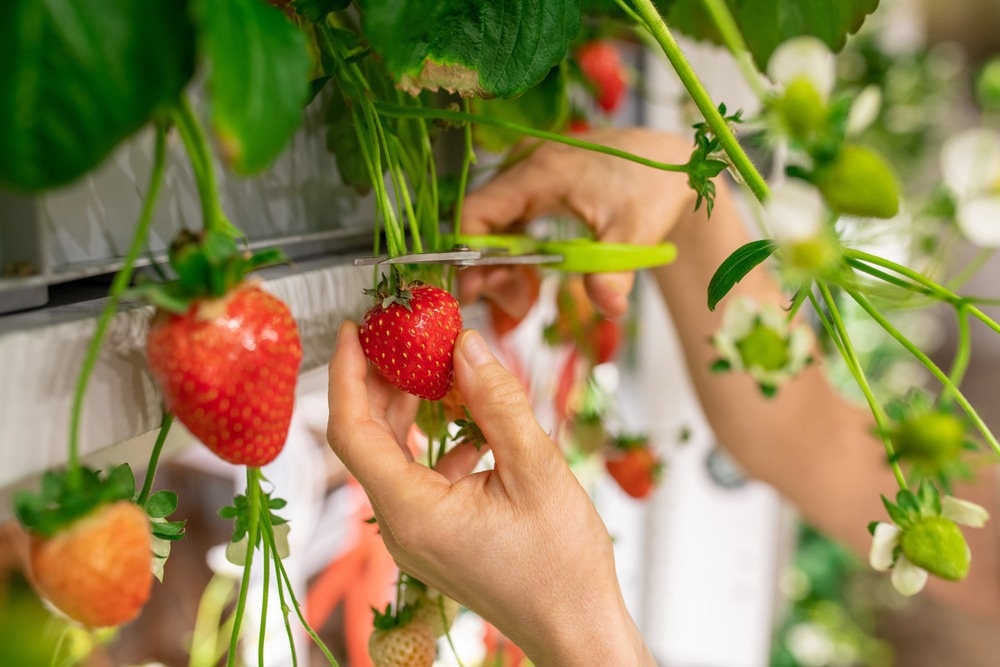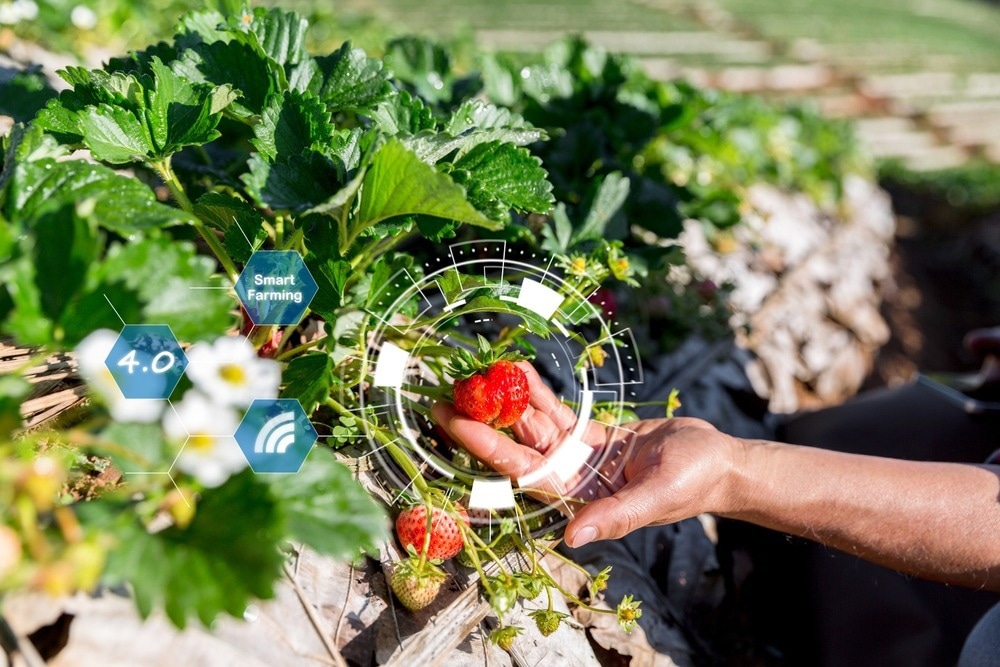In this article, we explore how the use of sensors is used to ensure that strawberry produce remains fresh and of high quality throughout the food supply chain.

Image Credit: Pressmaster/Shutterstock.com
Sensing technologies have a vital role in the food industry, especially in ensuring the freshness of perishable products throughout the food supply chain. Strawberries, an all-time summer fruit favorite for many, maintain their freshness from farm to shelf due to the implementation of technologies like sensors, the Internet of Things (IoT), and digital monitoring devices.
The use of these technologies enables a more efficient and transparent supply chain, thereby reducing waste and ensuring consumers receive high-quality products.
Environmental Monitoring Sensors
Environmental monitoring sensors are strategically placed within strawberry fields to continuously monitor and record critical environmental parameters, which include temperature, humidity, and air quality. By collecting real-time data, farmers gain insights into the field conditions.
For instance, if the temperature rises beyond the optimal range for strawberry growth, the sensors trigger alerts, allowing farmers to take immediate action, such as adjusting irrigation or deploying shade structures to protect the fruit to help optimize strawberry freshness during growth.
Harvesting Sensors
Smart harvesting machines are equipped with advanced sensors that evaluate the readiness of strawberries for picking. The sensors within these machines assess factors such as fruit firmness and color. By accurately determining the fruit's ripeness, the machines ensure that only ripe strawberries are harvested, thus consequently minimizing the chances of under-ripe or overripe berries entering the supply chain, preserving the quality and freshness of the crop.
Cold Chain Monitoring
After harvesting, strawberries often go through a cold chain, where they are subjected to controlled temperature and humidity conditions to extend their shelf life. Sensors are placed within refrigerated trucks, storage facilities, and shipping containers.
Such sensors continuously monitor and record the temperature and humidity levels, ensuring they remain within the optimal range. Any deviations from these conditions trigger immediate alerts to logistics personnel, enabling them to take corrective actions, such as adjusting the refrigeration settings or fixing any mechanical issues that may jeopardize the strawberries' freshness before they reach the shelves.
IoT-Enabled Tracking Devices
Internet of Things (IoT) devices, such as sensors and GPS trackers, are attached to packaging containers used to transport strawberries, collecting a wealth of data - including location, temperature, and humidity. After collection, the data is sent to a central system where it can be accessed and analyzed by supply chain managers.
In case of any unfavorable changes in the environment, such as a temperature increase or a delay in transportation, automated alerts are generated, thus ensuring that the strawberries are continually monitored.
Quality Assessment Sensors
Prior to reaching the retail shelves, strawberries undergo quality assessments using specialized sensors, whereby such quality assessment sensors use various techniques - for example, imaging and spectroscopy - to evaluate the condition of the fruit and detect issues like bruising, mold growth, or spoilage.
By swiftly identifying problematic berries, only those meeting the desired quality criteria are approved for sale. Hence, implementing this quality control process helps ensure that only fresh and appealing strawberries make it to the consumer.

Image Credit: Doidam 10/Shutterstock.com
Blockchain Technology
Blockchain technology, often integrated with IoT devices, offers an unalterable and transparent ledger of the entire strawberry food supply chain.
Each step of the strawberry's journey is recorded on the blockchain, allowing consumers to trace their strawberries' origins and handling, building trust and accountability in the supply chain. Moreover, in case of any quality issues or recalls, the blockchain provides a rapid and precise way to pinpoint affected batches, reducing the scope and impact of recalls and in turn, enhancing the efficiency of the food supply chain.
Data Analytics and AI
Data collected from the various sensors and monitoring devices are able to be processed and analyzed by artificial intelligence (AI), identifying patterns and trends that might lead to spoilage or quality issues. For example, the recognition that strawberries stored at a specific temperature for too long are more likely to deteriorate, and as such, armed with this predictive insight, supply chain managers will implement proactive measures to maintain the freshness of the strawberries - such as adjusting storage conditions or transport routes.
Conclusion
The integration of these technologies into the strawberry supply chain not only enhances the efficiency and freshness of strawberries; it reduces waste, cuts operational costs, and ensures consumers consistently receive the highest-quality produce available.
Sensor technologies offer numerous advantages to farmers, suppliers, and retailers, enabling data-driven decision-making, maintaining the integrity of their products, and meeting the ever-increasing demand for fresh and healthy strawberries.
References and Further Reading
Carlos, J. A. D., et al. (2020) Monitoring system of environmental variables for a strawberry crop using IoT tools. Procedia Computer Science. 170, pp. 1083–9.
Censis. Smart strawberries crop increases quality and reduces time from farm to market [online]. CENSIS. 2016 [cited 2023 Oct 12]. Available from: https://censis.org.uk/2016/01/19/smart-strawberries-crop-increases-quality-and-reduces-time-from-farm-to-market/
Wilson D. (2021) Chemical Sensors for Farm-to-Table Monitoring of Fruit Quality. Sensors, 21(5), p. 1634.
The strawberry chain [online]. freshknowledge.eu. (2021). Available from: https://www.freshknowledge.eu/en/knowledge-database/crops/strawberry-1/the-strawberry-chain.htm
Cruz, M., et al. (2022). Smart Strawberry Farming Using Edge Computing and IoT. Sensors, 22(15), p.5866.
Dhanaraju, M., et al. (2022). Smart Farming: Internet of Things (IoT)-Based Sustainable Agriculture. Agriculture, 12(10), p. 1745.
Weng, S., et al. (2022). Non-Destructive Detection of Strawberry Quality Using Multi-Features of Hyperspectral Imaging and Multivariate Methods. Sensors, 20(11), p.3074. Available from: https://www.mdpi.com/1424-8220/20/11/3074
Innovation, H. New technology in strawberry production. [online]. www.horticulture.com.au. [cited 2023 Oct 12]. Available from: https://www.horticulture.com.au/growers/help-your-business-grow/research-reports-publications-fact-sheets-and-more/grower-resources/bs15002-assets/new-technology-in-strawberry-production/
Tyrrell, J. (2023). Strawberries and AI: deep learning ripe to grow food industry profits. [online] TechHQ. Available from: https://techhq.com/2023/06/strawberries-and-ai-deep-learning-digests-flavor-and-food-waste/
Disclaimer: The views expressed here are those of the author expressed in their private capacity and do not necessarily represent the views of AZoM.com Limited T/A AZoNetwork the owner and operator of this website. This disclaimer forms part of the Terms and conditions of use of this website.